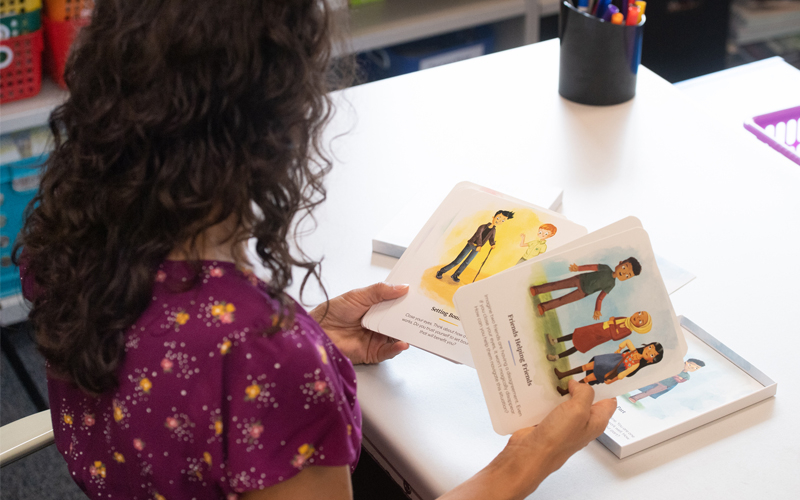

Facing Challenging Feelings in the Classroom

Why Challenging Feelings Matter
Challenging feelings are uncomfortable—but they all have a purpose. It is typical to experience a variance of emotion at any age. Our emotions can change in intensity. For example, an emotion such as anger can range from annoyance to rage. As we develop, learning how to regulate our feelings is key in leading healthy, full, and productive lives. Research shows that frequent conversation about our emotions in adult-child relationships helps parents and teachers with their own emotional awareness, and can help in improving students’ emotional knowledge and addressing behavior issues (Havighurt et al., 2010).
Without experiencing difficult emotions, we wouldn’t be able to spring into action on issues that are important to us. We rely on the skill of persistence as we exercise our competence in assertiveness. This SEL competency helps us reframe mistakes or setbacks as a structure for learning about the future. Opportunities to work through challenging feelings can become lessons in refining a skill, instead of shying away from new learning. Challenging feelings matter because all emotions matter. Every emotion serves a purpose and is important to recognize, whether it is uncomfortable or not.

What Challenging Feelings Look and Sound Like
Naming and addressing challenging or positive feelings is the first step in improving a student’s emotional literacy. When we are able to give an uncomfortable feeling a name, it becomes less intrusive, as we empathize with others who have felt similarly in the past. Naming will also give us more confidence and help us to exercise autonomy over our body and thoughts (McElhaney & Allen, 2001). When a challenging situation occurs, it can send students into a cycle of negative thoughts in which they experience physical and emotional reactions that can lead to unproductive actions. Using calming methods like focusing on breathing or playing music can help students manage their emotions and stay on a successful path (Rolston & Lloyd-Richardson, n.d.). Consider what the following difficult feelings can look and sound like:
- Sadness. All emotions vary in intensity, and when a student is feeling sad it may change from pensiveness to sadness and end in grief. The student’s feelings could include listlessness, insomnia, lack of appetite, and chest aches, which may be expressed by crying or being tired or withdrawn.
- Disgust. The emotion of disgust can range from boredom to loathing. People experiencing disgust may feel the need to flee or they may express revulsion by curling their lip or wrinkling their nose.
- Anger. Although anger can be shown in different ways, at times it will begin with annoyance, change into anger, and culminate in rage. A student who feels anger may experience elevated body temperature or sweating. Feelings of anger may be indicated by an elevated tone of voice and a furrowed brow. A student experiencing anger in this way may need to engage in breathing exercises or movement to calm their emotions and body.

Cultivating Self-Awareness Through Conversation
New routines and transitions can bring challenging feelings like annoyance and sadness. Being aware of your class’s emotional well-being can help you to set the tone in your classroom and allow you and your students to have greater success in the school year. Before the year begins, imagine scenarios or topics that might cause uncomfortable feelings. Remember that those scenarios will be different for every student, as they all bring their unique lens or perspective to the classroom.
After making a plan to address the scenarios you’ve considered, know that challenging feelings or conversations may arise from these topics. Consider these strategies for becoming more aware of strong emotions:
- Get to know your students. This might seem simple, but knowing your students outside your relationship in the classroom will help you to notice challenging thoughts or feelings as they arise. Pay attention to the things that matter to your students, their extracurricular activities, “mood boosters,” or familial relationships to better understand their behavior and feelings in challenging situations (Derek Bok Center, n.d.).
- Body language. As the semester progresses, so do teacher-student relationships and feelings of trust. Note how your class responds to routine procedures on a normal basis, so when a student seems withdrawn or closed off you will be able to give them extra support. If moments like this occur, take the time to participate in “body language” exercises, in which students describe emotions by naming and acting them out. This helps students to develop awareness in a team setting and empathy for others experiencing strong feelings (Miller, 2021).
- Check in. With routine check-ins, students, teachers, and parents can be on the same team when working together through challenging emotions. Consider sharing a communication check-in through a school planner, digital tool, or simple pen and paper. When students feel overwhelmed or out of control, authentically ask how they are doing, practice mindfulness techniques, or encourage them to show their feelings through artwork, music, or journaling (Beyond Blue, n.d.).
Difficult feelings may arise, but remember that every emotion has a purpose. How we express challenging behavioral emotions depends on how we regulate and respond to them. Using our own life experiences, it is helpful to consider and reflect on our own emotional regulation tendencies and how we can help instill new responses in our students.
References:
Beyond Blue. (n.d.) Why emotions matter. https://healthyfamilies.beyondblue.org.au/age-1-5/social-and-emotional-development/why-emotions-matter
Derek Bok Center for Teaching and Learning. (n.d.) Key moves. Harvard University. https://bokcenter.harvard.edu/inclusive-moves#navigating-difficult-moments
Havighurst, S. Sophie, Wilson, K. R., Harley, A. E., Prior, M. R., & Kehoe C. (2010). Tuning in to Kids: Improving emotion socialization practices in parents of preschool children—findings from a community trial. Journal of Child Psychology and Psychiatry, 51(12), 1342–1350. https://acamh.onlinelibrary.wiley.com/doi/abs/10.1111/j.1469-7610.2010.02303.x
McElhaney, K. B. & Allen, J. P. (2001). Autonomy and adolescent social functioning: The moderating effect of risk. Child Development, 72(1), 220–235. https://www.ncbi.nlm.nih.gov/pmc/articles/PMC1551976/
Miller, K. (2021, October 29). Building self-awareness: 16 activities and tools for meaningful change. PositivePsychology.com. https://positivepsychology.com/building-self-awareness-activities/





